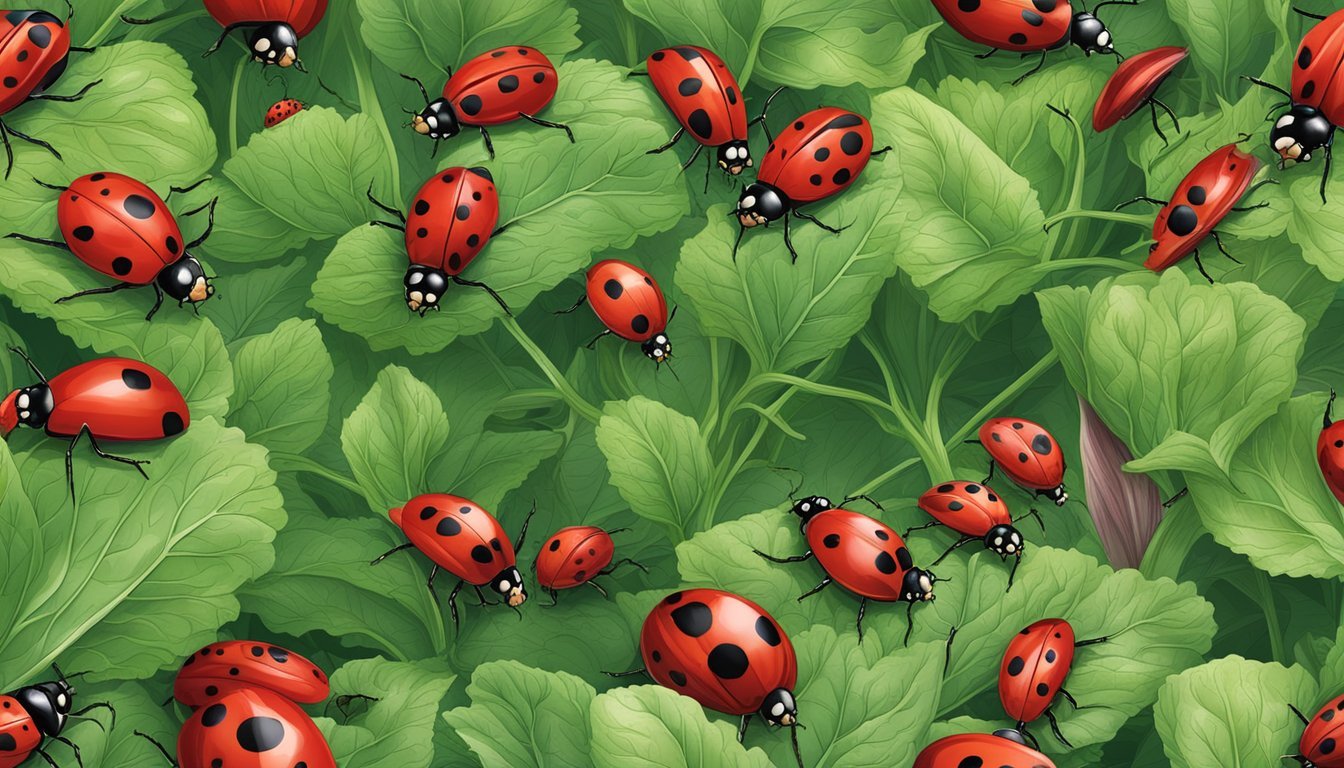Pest Control for Beets
Effective Strategies for Healthy Crops
Beet crops are essential to many home gardeners and commercial growers for their nutritional value and versatility in cooking. However, these plants can be susceptible to a range of pests that, if left unmanaged, can lead to significant crop loss and affect the quality of the harvest. It is crucial to identify and control these pests to maintain healthy beet plants and ensure a bountiful yield.
Effective pest management begins with understanding the most common beet adversaries. Aphids, leafhoppers, flea beetles, and leaf miners are among the pests that can severely damage beet crops. These pests not only feed on the leaves and roots, causing direct harm to the plants, but they can also act as vectors for diseases. Monitoring the garden for signs of infestation and taking action at the first sign of trouble is key in preventing pest populations from getting out of control.
In employing pest control strategies, it's important to balance effectiveness with environmental considerations. There are various organic and conventional methods available to protect beets (how long do beets last?) from pests, including the use of diatomaceous earth, implementing crop rotation, and the strategic removal of affected plants. Gardeners and farmers must decide which methods best fit their horticultural practices and pest control needs.
Understanding Beet Pests
Effective management of beet pests requires knowledge of their types, life cycles, and the damage they inflict. Early identification and understanding of pest behaviors are crucial for maintaining healthy beet crops.
Common Pests and Their Identification
Beet crops are susceptible to a variety of pests, each with distinct characteristics and symptoms of infestation:
Aphids: Small, pear-shaped insects that can be green, black, brown, or red. They cluster on the undersides of leaves and stems, leaving behind a sticky residue called honeydew.
Cutworms: These are caterpillar larvae that curl into a C-shape when disturbed. They typically feed at night, cutting off young plants at the soil line.
Flea Beetles: Small, jumping beetles which chew numerous small, round holes through beet leaves.
Leafhoppers: Green or yellow insects that suck sap from leaves, causing "hopperburn," which makes leaves curl and turn yellow.
Beet Leafhopper: A specific type of leafhopper known to transmit the beet curly top virus, causing stunted growth and leaf curling.
Nematodes (Beet Cyst Nematode): Microscopic roundworms that attack beet roots, forming visible cysts and leading to reduced growth and yield.
Seed Corn Maggots: The larvae of a fly, which feed on beet seeds and young seedlings, can lead to poor germination or plant death.
Beet Webworm: Greenish caterpillar larvae that feed on leaves creating thin, webbed areas.
Lifecycle and Habits of Beet Pests
Understanding the lifecycle and habits of beet pests can inform control strategies:
Aphids: Reproduce rapidly, mainly in spring and summer. They can give birth to live young without mating.
Cutworms & Beet Webworm: Go through complete metamorphosis from egg to larva to pupa and then adult, with larvae causing the primary damage.
Flea Beetles: Lay eggs near the base of plants, and new larvae emerge to feed on roots before adults emerge in late spring to feed on foliage.
Leafhoppers & Beet Leafhopper: Adults overwinter in plant debris and lay eggs in spring. Nymphs and adults both feed on plant sap.
Nematodes: Have multiple generations per year, spread through soil and water movement, and form cysts on roots that contain eggs.
Seed Corn Maggots: Fly adults lay eggs near seeds, and the hatching larvae burrow into the seed or seedling.
Impact of Pests on Beets
Pests can significantly impact beet crops through:
Physical Damage: Leaves, stems, and roots can be scarred, pierced, or consumed, leading to reduced photosynthesis and plant vigor.
Disease Transmission: Pests like beet leafhoppers are vectors for diseases such as beet curly top virus, which can severely impact plant growth and crop yield.
Physiological Stress: Pest infestations can put tremendous stress on plants, leading to wilting, stunted growth, and in severe cases, plant death.
Gardeners must monitor their beet crops closely to identify pest presence early and take appropriate measures to manage the infestation and mitigate damage.
Cultural Pest Control Strategies
Cultural pest control strategies involve non-chemical practices that deter or mitigate pest damage in vegetable gardens. These practices are particularly invaluable for beet cultivation, addressing common pests through preventive measures and by creating an environment that is less conducive to pest proliferation.
Crop Rotation and Plant Diversity
Crop rotation is a vital strategy in disrupting pest life cycles. By alternating beet planting with different vegetables, such as onions, (What wine goes well with onions?) lettuce, radishes, or garlic, one can reduce the build-up of beet-specific pests. Introducing a variety of plants enhances the plant diversity within a garden, which can help in preventing pest outbreaks. For instance, rotating cool season crops like beets with turnips and early spring vegetables disrupts many soil-bound pests.
Timely Planting and Harvesting
The timing of planting and harvesting can significantly impact pest management. Planting beets early in the season when weather conditions are less favorable for pests, or late in the summer to avoid peak pest populations, can result in fewer pest problems. Efficient harvesting ensures that pests do not have a food source to thrive on, thereby reducing their potential to damage future crops.
Soil Management
Soil management is a fundamental component of cultural control methods. Maintaining the soil level with adequate nutrients, such as iron, supports healthy plant growth, which can make plants less susceptible to pests. Regular applications of mulch can regulate soil temperature and moisture, deter weeds, and prevent many soil-borne pests from reaching the plants. It is crucial to keep the soil well-drained yet moist, as excessive dampness can attract pests.
Physical Pest Control Measures
In the context of beet cultivation, it is vital to implement effective physical pest control strategies. These measures are targeted at preventing and mitigating pest damage in a direct manner, utilizing tools and environment management that discourage pest presence and activity.
Utilization of Row Covers
Floating row covers provide an immediate barrier between pests and beet plants. They are made from lightweight fabric that allows sunlight, water, and air to pass through while keeping insects at bay. For preventing pests like leaf miners and flea beetles, gardeners can use floating row covers immediately after planting.
Advantages:
Provide a physical barrier against insects.
Allow for essential air circulation and light penetration.
Proper Watering Techniques
The health of beet plants can be significantly affected by watering practices. Overwatering can lead to conditions favorable for pest outbreaks, whereas consistent and appropriate watering strengthens plants against pests. Furthermore, proper water management can help avoid root rots and other water-borne diseases.
Recommendations:
Water beets deeply but infrequently to promote strong root systems.
Ensure soil has good drainage to prevent excessive moisture.
Mechanical Barriers and Traps
Mechanical tools like sticky traps and barriers made of diatomaceous earth can effectively control specific pest populations. Sticky traps attract and capture flying insects, reducing their numbers. The application of diatomaceous earth around the base of the beet plants acts as a deterrent for crawling insects due to its abrasive quality.
Effective Tools:
Sticky traps: Best positioned at ground level to catch maggot flies and other pests.
Diatomaceous earth: Sprinkle around beet plants to ward off slugs and snails.
Biological Pest Control Methods
Biological pest control methods harness nature's own mechanisms to manage pests, focusing on long-term treatment rather than quick fixes. By encouraging ecosystems to work in favor of one's crops, these methods can be sustainable alternatives to chemical pesticides.
Encouraging Beneficial Insects
Creating an environment that attracts beneficial insects can significantly reduce the population of pests. For beets, ladybugs and lacewings are particularly effective against aphids. Planting flowers like alyssum or herbs like dill nearby can provide the habitat necessary for these insects to thrive. Additionally, incorporating neem oil as a treatment can deter pests without harming beneficial insects, thus protecting the beet crop in unfavorable weather.
Application of Beneficial Nematodes
Beneficial nematodes are microscopic worms that can be used as a natural control method for beet pests like root maggots. As soil-dwellers, they invade and kill various larvae before they can damage the crops. Introducing beneficial nematodes into the soil is a targeted treatment that can help control pests without the downsides associated with chemical use.
Using Predators and Parasites
Leveraging natural enemies like predators and parasites can be effective in managing pests. Predators such as birds can help control the population of rodents and rabbits that may harm beet crops, while certain wasp species act as parasites that target specific beet pests. Introducing or conserving habitats for these predators ensures ongoing pest control. Similarly, using parasitic wasps against beet cyst nematodes can provide relief from these particular pests. Control methods involving parasites focus on disrupting the pests' life cycle, which provides a long-term reduction in their numbers without affecting non-target species.
Chemical Pest Control Options
When managing pest populations in beet cultivation, gardeners have the option of using both organic pesticides and synthetic chemical treatments. These methods, when chosen carefully and applied correctly, can significantly reduce the damage caused by pests and diseases that affect beet crops.
Organic Pesticides
Organic pesticides are derived from natural sources and are often considered safer alternatives to synthetic chemicals. They can provide efficient control against pests without introducing harmful substances into the environment. Neem oil is a popular organic treatment that acts as an insect repellent and is effective against various pests like aphids and mites. Another common option is insecticidal soap, which disrupts the cell membranes of soft-bodied insects, leading to their dehydration and death. Applications of these pesticides should be carefully timed and executed according to the product instructions to ensure efficacy.
Neem Oil: Used to control various pests; apply as per labeled directions.
Insecticidal Soap: Effective against soft-bodied insects; avoid application during high temperatures to reduce plant stress.
Synthetic Chemical Treatments
Synthetic chemicals are man-made insecticides that offer a more potent and sometimes longer-lasting solution for pest control. Spinosad is an example of a synthetic product that is formulated from naturally occurring substances. It targets the nervous system of insects, offering effective treatment while still being labeled for organic use in some cases. For severe pest infestations, synthetic chemical options might be the most viable, but always consider the manufacturer's guidelines regarding application rates and safety precautions to minimize risks to the environment and beneficial organisms.
Spinosad: Targets insect nervous systems; observe safety precautions and usage directions for optimal control.
By understanding the differences between organic pesticides and synthetic chemical treatments, one can make informed decisions to maintain the health of beet crops and control various pests and diseases effectively.
Management of Beet Diseases
Effective management of beet diseases involves accurate identification, adopting preventive measures, and implementing proper treatment approaches to ensure healthy beet growth.
Identifying Common Beet Diseases
To control beet diseases, it's critical to recognize their symptoms. Cercospora leaf spot manifests as small reddish or purple spots which enlarge to form circular areas with gray centers. Downy mildew is indicated by light green to yellow patches on leaf surfaces and a fuzzy growth on the underside. Beet curly top virus causes leaves to curl and show yellowing or reddening. It's often spread by leafhoppers. Powdery mildew appears as a white powdery substance on the upper surface of leaves.
Preventive Measures for Diseases
Prevention is essential in the battle against beet diseases. One key strategy is crop rotation, which disrupts the disease cycle. Cultivating beets in locations that receive full sun and maintaining good air circulation around plants can inhibit the growth of fungi. Soil health is also critical; ensure proper fertilization and pH level management. Selecting disease-resistant varieties can offer inherent protection against certain pathogens.
Treatment Approaches for Diseases
Should beet diseases occur, treatment is necessary to salvage the crop. For Cercospora leaf spot, fungicides containing copper can be used, but they must be applied at the first sign of the disease. Downy mildew may also be treated with fungicides, and prompt removal of affected plant material helps prevent the spread. There is no cure for beet curly top virus once plants are infected—removal and destruction of afflicted plants are recommended to prevent further transmission. Managing vectors like leafhoppers is crucial for control. For powdery mildew, fungicides and sulfur treatments can be effective when applied early.
Providing plants with optimal growing conditions and responding quickly at the first sign of disease will minimize losses due to beet diseases. Regular monitoring is necessary to detect early symptoms and take action.
Companion Planting and Intercropping
Effective pest control for beets often involves the strategic use of companion planting and intercropping to leverage the natural relationships between different plants. These methods not only discourage pests but can also promote a more robust and bountiful harvest.
Choosing the Right Companions
When planting beets, gardeners should consider including vegetables like cabbage and chard, as well as herbs such as thyme and catnip. These plants are known to attract beneficial insects that help control beet pests. Onions and garlic, for example, are reputed for their ability to deter pests like aphids and beet leafhoppers.
Benefits of Intercropping
Intercropping involves growing two or more crops in proximity for a range of benefits, including pest control, better use of space, and improved soil health. For beets, pairing them with the right companions can minimize disease spread, attract predators of common beet pests, and create an environment unfriendly to pests without the use of chemical treatments.
Layout and Spatial Strategies
Implementing a strategic layout in the vegetable garden maximizes sun exposure and air circulation, both crucial for the healthy growth of beets. Crop rotation should be considered as part of these strategies to prevent soil-borne diseases and pests. Implementing rows or blocks that mix beets with compatible plants can lead to more efficient use of space and sunlight, ensuring that each beet plant receives optimal conditions for growth, whether they are red beet, white beet, or beetroot varieties.
Monitoring and Early Detection
In the realm of beet cultivation, the adage 'prevention is better than cure' is apt, as monitoring and early detection are pivotal for maintaining healthy crops. Vigilance can thwart the escalation of pests that feast on beet plants, and recognition of early symptoms facilitates prompt control measures.
Regular Garden Inspections
They should inspect their beet crops at least twice a week for any potential threats. This includes looking for holes in the leaves, webbing, and any unusual yellowing that may indicate the presence of pests like beet leafhoppers or beet moth webworms. Utilizing sticky traps can aid in capturing and identifying pests early on.
Maintaining Garden Records
An organized gardener keeps meticulous records of their observations. This includes dates of pest sightings, descriptions of the symptoms, and details of control actions taken. Consistent record-keeping can reveal patterns or reoccurrences, paving the way to more tailored and successful control strategies.
Understanding Warning Signs
Gardeners must be versed in the symptoms indicative of pest infestations. Yellowing leaves may suggest nutrient deficiencies or the presence of pests. Webbing on plants points to the activity of webworms. They should also be familiar with the life cycle and behavior of common pests, using research and historical records to predict and intercept events before they unfold.
Advanced Topics in Pest Control
Advancements in pest control for beets focus on sustainable strategies, extensive research, and embracing novel approaches to mitigate future challenges.
Integrated Pest Management (IPM)
Integrated Pest Management (IPM) is a science-based, decision-making process that identifies and reduces risks from pests and pest management related strategies. It incorporates a variety of management approaches including biological, cultural, and chemical methods. For sugar beet pest management, it's essential to understand the pest's biology and lifecycle to effectively reduce their impact on the crop.
Research and Extension Outreach
Research in beet pest control is vital for developing new strategies to combat diseases and pests. Extension programs play a key role in disseminating up-to-date, research-based information to growers. For instance, university-led research often results in outreach events where growers can learn about the latest findings in disease and pest control.
Future Trends in Pest Control
Looking ahead, pest control for beets will likely embrace a combination of traditional practices and cutting-edge technologies. These may include genetic modification to enhance beet resistance to diseases and pests, advanced biological control agents, and precision agriculture techniques. Understanding the ecosystem and the climatic changes that affect pest patterns will also be critical for developing proactive control measures.
Frequently Asked Questions
Effective pest control in beets requires knowledge of the pests involved and the appropriate methods of management. Below, the most common questions relating to beet pest control are answered with precise methods meant to tackle specific issues.
What methods are effective for managing leaf miners on beet plants?
Leaf miners on beet plants can be managed by regularly inspecting and removing infested leaves, utilizing floating row covers, or applying insecticides labeled safe for leaf miner control when necessary.
How can one prevent mice from damaging beetroot crops?
To prevent mice from damaging beetroot crops, one can use traps strategically, keep the garden tidy to reduce hiding places, or surround the crops with a mesh wire fence dug into the ground.
What are the common diseases affecting beetroot plants and how can they be controlled?
Common diseases affecting beetroot plants include leaf spot, Cercospora leaf blight, and fusarium wilt. These can be controlled by using disease-resistant varieties, providing proper plant spacing for airflow, and applying organic fungicides when necessary.
Which insecticides are safe and effective to use on beets?
Insecticides containing pyrethrins or spinosad are safe and effective for use on beets and can deter a variety of pests like aphids, leafhoppers, and flea beetles, always respecting the instructions provided by the manufacturer.
What treatments are available for beet rust control?
For beet rust control, it's necessary to apply fungicides that contain active ingredients effective against rust disease, ensure proper irrigation practices to reduce leaf wetness, and remove infected plant debris to reduce spore spread.
How can I identify and treat bugs that are eating my beet plants?
One can identify bugs on beet plants by carefully inspecting leaves and stems for insects or signs of their damage. Treatments may include handpicking bugs, applying diatomaceous earth, or using suitable insecticides as part of integrated pest management.








